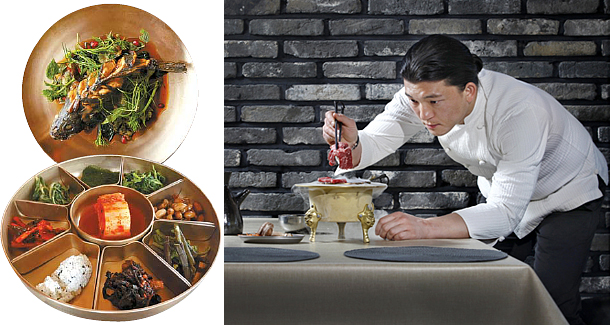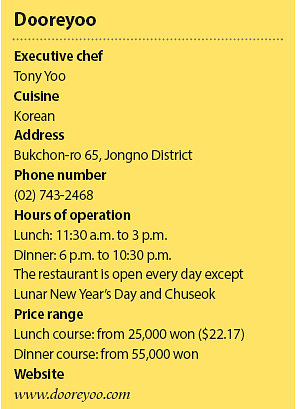A new taste, inspired by the past

Chef Tony Yoo cooks meat at his restaurant Dooreyoo in Jongno District, central Seoul. At left top is a dish that is served as one of the meals at his restaurant. At left bottom is a selection of banchan, small side dishes. [TONY YOO, LEE SUN-MIN, PARK SANG-MOON]
While globally-known cooking schools were accepting applications from both men and women wanting to master French, Italian and other cuisines, there were limited opportunities for men to learn from Korean food experts, the majority of which were women at the time.
That man, Tony Yoo, is now a Michelin-starred chef in Korea. He worked his way up in the kitchen while working at restaurants here and overseas to expand the skills and knowledge he got from his father’s Korean food restaurant while growing up. And when the Michelin Guide published its first book in Seoul last year, 24 Seasons, the restaurant where Yoo was serving as executive chef earned one star.
Being rejected from the private cooking academies really worked to his benefit. He started working in restaurant kitchens instead, which assured him that what he wanted to do was cook Korean food: making what has been around for a long time and updating it for the current generation. He often finds even chefs, professional or amateur, saying that Korean food is too difficult to make. Just as he had hard time finding a place to study Korean food, many find themselves in a similar position without a widely-known institution for the cuisine.

“Many fancy chasing something new and often neglect [the fact that] what they already have can be something new.”
To live by his intentions, he took a step early this year and opened a new restaurant called Dooreyoo in Gahoe-dong, Jongno District, central Seoul, leaving his restaurant and its international recognition. But he didn’t fancy creating something completely new. He took the name of a local Korean food restaurant called Doore located in central Seoul, which first opened for business almost 50 years ago in South Gyeongsang.
By simply adding his last name to the existing name, he has shown his strong will to add a modern touch to traditional Korean cuisine. He makes fermented sauces like soy sauce together with the restaurant Doore, trying to take a classic approach that can be updated and further developed with his skills learned in the United Kingdom, the United States, Australia and Japan, along with his experience in restaurants here.
He tries to serve food in a style commonly known as hanjungsik, a Korean word that means Korean food served in courses. He uses porcelain dishware and brass items that look like those often depicted in books that explain traditional food. He also cites fables he has read in ancient books and paintings from Korea’s ancient kingdoms to make the overall dining experience a cultural one and make it feel like a trip back and forth between old and modern times.
In an attempt to show his passion in being the bridge of what’s old and new as well as to differentiate his version of Korean food from the works of other chefs in Korea, he focuses on foraged plants and captured wild animals. He uses local rabbits and pheasants and young shoots and sprouts from wild trees to show how the application of modern techniques can bring out new flavors from what’s existed for ages.
“Foraging can be seen as something primitive, as using what’s around in food has long been how people get nutrition,” said the chef, adding that the process is a two-way street. Diners get to learn what is available in Korea and the chef learns whether he can present a new range of ingredients to diners and they enjoy it.
“The key is to increase the overall quality of the dishes with the diners,” said the chef.
To help what’s known as traditional Korean cuisine wear new clothes, the chef has been going overseas to take part in major culinary events. He makes sure to bring simple ingredients like sesame oil to inspire chefs elsewhere to try the new ingredients and practice using them while making their own recipes.
BY LEE SUN-MIN [summerlee@joongang.co.kr]










with the Korea JoongAng Daily
To write comments, please log in to one of the accounts.
Standards Board Policy (0/250자)